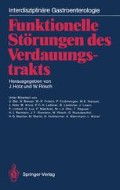Zusammenfassung
Der Begriff „non-ulcer dyspepsia“ gehört in den angelsächsischen Ländern seit Jahrzehnten zum Sprachgebrauch der Kliniker. Das Krankheitsbild, das man mit Non-ulcer-Dyspepsie beschreibt, ist auch in der jüngsten Literatur nur unscharf definiert. Der Begriff der Non-ulcer-Dyspepsie im engeren Sinne sollte nur für die Patienten Anwendung finden, die über Oberbauchbeschwerden klagen, die auf ein Ulkus hinweisen, und bei denen mittels Endoskopie des oberen Gastrointestinaltrakts ein Ulkus ausgeschlossen wurde. Der fehlende Nachweis eines Ulkus im Rahmen einer Magen-Darm-Passage reicht für die Diagnose einer Non-ulcer-Dyspepsie nicht aus, da diese Patienten in 10–40% aller Fälle eine Ulkuskrankheit entwickeln [2, 7, 10, 16, 17, 37].
Preview
Unable to display preview. Download preview PDF.
Literatur
Banke L (1975) Ulcussygdommens Epidemiologi. Thesis Fadl’s forlag, København
Barfred A (1959) Proceedings of the World Congress of Gastroenterology. Williams & Wilkins, Baltimore, p 252
Beck IT, Kahn DS, Lancerte M, Solymar S et al. (1965) Chronic duodenitis: a clinical pathological entity? Gut 6:376–383
Beaumont W (1959) Experiments and observations on the gastric juice and the physiology of digestion. Dover, New York, p 107
Bonnevie O (1982) Outcome of non-ulcer disease. Scand J Gastroenterol 75 [Suppl]: 135–138
Bonnevie O, Kallehauge HE, Wulff HR, Wulff M (1971) Prognostic value of the augmented histamin test in ulcer disease and X-ray negative dyspepsia. Scand J Gastroenterol 6:723–729
Brummer P, Häkkinen I (1959) X-ray negative dyspepsia: a follow-up study. Acta Med Scand 165:329–332
Dal Monte PR, D’Imperio N, Accardo P, Daniotti S (1982) Pirencepine in non-ulcer dyspepsia: a double-blind, placebo controlled trial. Scand J Gastroenterol 17 [Suppl 72]:247–250
Englert W, Schlick D (1979) A double-blind crossover trial of domperidone in chronic postprandial dyspepsia. Postgrad Med J 55 [Suppl]:28–29
Gregory DW, Davies GT, Evans KT, Rhodes J (1972) Natural history of patients with X-ray negative pepsia in general practice. Br Med J 4:519–520
Haarmann K, Lebküchner F, Widmann A, Kief W et al. (1979) Die symptomatische Behandlung chronischer postprandialer Beschwerden mit Motilium (Domperidon). Ergebnisse einer Doppelblindstudie. Med Welt 30:302–306
Hradsky M, Wikander M (1982) Effect of pirenzepine in the treatment of non-ulcer dyspepsia: a double blind study. Scand J Gastroenterol 17 [Suppl 72]:251–252
Kelback H, Linde J, Eriksen J, Munkgaard S et al. (1985) Controlled clinical trial of treatment with Cimetidine for non-ulcer dyspepsia. Acta Med Scand 217:281–287
Kleveland PM, Larsen S, Sandvik L, Kristensen P et al. (1985) The effect of Cimetidine in non-ulcer dyspepsia: Experience with a multi-cross-over model. Scand J Gastroenterol 20:19–24
Knill-Jones RP (1985) A formal approach to symptoms in dyspepsia. Clin Gastroenterol 14:517–529
Krag E (1965) Pseudo-ulcer and true peptic ulcer. A clinical, radiographic and statistical follow-up study. Acta Med Scand 178:713–728
Krag E (1969) The pseudo-ulcer syndrome. A clinical, radiographic and statistical follow-up study on patients with ulcer symptoms but no demonstrable ulcer in the stomach or duodenum. Danish Med Bull 16:6–9
La Brooy S, Lowell D, Misiewicz JJ (1978) The treatment of non ulcer dyspepsia. In: Wastell C, Lance P (eds) Cimetidine: the Westminster Hospital Symposium, edn. Churchill Livingstone, Edinburgh, pp 131–137
Lance P, Filipi MI, Schiller KFR, Wastell C (1981) Cimetidine for non ulcer dyspepsia. Gastroenterology 80:1203
Mirsky IA (1958) Physiologic, psychologic and social determinants in the ethiology of duodenal ulcer. Am J Dig Dis 3:285–314
Mollmann KM, Bonnevie O, Gudmand-Høyer E, Wulff HR (1975) A diagnostic study of patients with abdominal pain. Scand J Gastroenterol 10:805–809
Müller-Lissner SA, Fimmel CJ, Sonnenberg A, Will N et al. (1983) Novel approach to quantity duodenogastric reflux in healthy volunteers and in patients with type I gastric ulcer. Gut 24:510–518
Nesland AA, Berstad A (1985) Effect of Cimetidine in patients with non-ulcer dyspepsia and erosive prepyloric changes. Scand J Gastroenterol 20:629–635
Nielsen VG, Jørgensen B (1971) Syresekresjonen hos patienter med ulcus duodeni of pseudo ulcussyndrom. Ugeskr laeg 133:1025–1027
Nørrelund N, Helles A, Schmiegalow M (1980) Uncharacteristic dyspepsia in general practice. A controlled trial with an antacid (Alminox). Ugeskr laeg 142:1750–1753
Nyren O, Adami HO, Gustavsson S, Lööf L et al. (1985) Social and economic effects of non-ulcer dyspepsia. Scand J Gastroenterol 20 [Suppl 109]:41–45
Nyren O, Gustavsson S, Adami HO, Lööf L (1985) Methodological aspects of clinical trials in non-ulcer dyspepsia with special reference to selectional factors. Scand J Gastroenterol 20 [Suppl. 109]:159–162
Petersen H (1982) Antacids in non-ulcer dyspepsia. Scand J Gastroenterol 75 [Suppl]:77–78
Reynolds RPE, Bardakjian BL, Diamant NE (1983) A case of antral tachygastria: symptomatic and myoelectric improvement with gastroenterostomy and domperidone therapy. Can Med Assoc J 128:826–829
Schulze-Delrieu K (1981) Metoclopramide. N Engl J Med 305:28–33
Sekar ASC, Thompson WG, Turner LJ, Barr R (1977) Duodenogastric reflux and gastritis in non-ulcer dyspepsia. Clin Res 24:667
Spiro HM (1974) Moynihan’s disease? The diagnosis of duodenal ulcer. N Engl J Med 291:567–569
Thompson WG, Heaton EW (1980) Functional bowel disorders in apparently healthy people. Gastroenterology 79:283–288
Van de Mierop L, Rutgeerts L, Van den Langenbergh B, Straessen A (1979) Oral domperidone in chronic postprandial dyspepsia. A double blind placebo-controlled evaluation. Digestion 19:244–250
Van Outryve M, Lauwers W, Verbeke S (1979) Domperidone for the symptomatic treatment of chronic postprandial nausea and vomiting. Postgrad Med J 55 [Suppl]: 33–35
Viskum K (1977) Ulcer disease. A comparison of some clinical and genetic aspects in patients suffering from duodenal ulcer, gastric ulcer and the pseudoulcer syndrome. Danish Med Bull 24:313–335
Wolf S, Wolff HG (1942) Evidence on the genesis of peptic ulcer in man. JAMA 120:670–675
Wright SH, Snape WJ, Battle W, Cohen S et al. (1980) Effect of dietary components on gastrocolonic response. Am J Physiol 238:G228–G232
You CH, Chey WY, Lee KY, Menguy R et al. (1981) Gastric and small intestinal myoelectric dysrhythmia associated with chronic intractable nausea and vomiting. Ann Intern Med 95:449–451
Editor information
Editors and Affiliations
Rights and permissions
Copyright information
© 1987 Springer-Verlag Berlin Heidelberg
About this chapter
Cite this chapter
Fritsch, WP. (1987). Klinik der Non-ulcer-Dyspepsie (Reizmagen). In: Hotz, J., Rösch, W. (eds) Funktionelle Störungen des Verdauungstrakts. Interdisziplinäre Gastroenterologie. Springer, Berlin, Heidelberg. https://doi.org/10.1007/978-3-642-72680-4_13
Download citation
DOI: https://doi.org/10.1007/978-3-642-72680-4_13
Publisher Name: Springer, Berlin, Heidelberg
Print ISBN: 978-3-642-72681-1
Online ISBN: 978-3-642-72680-4
eBook Packages: Springer Book Archive

